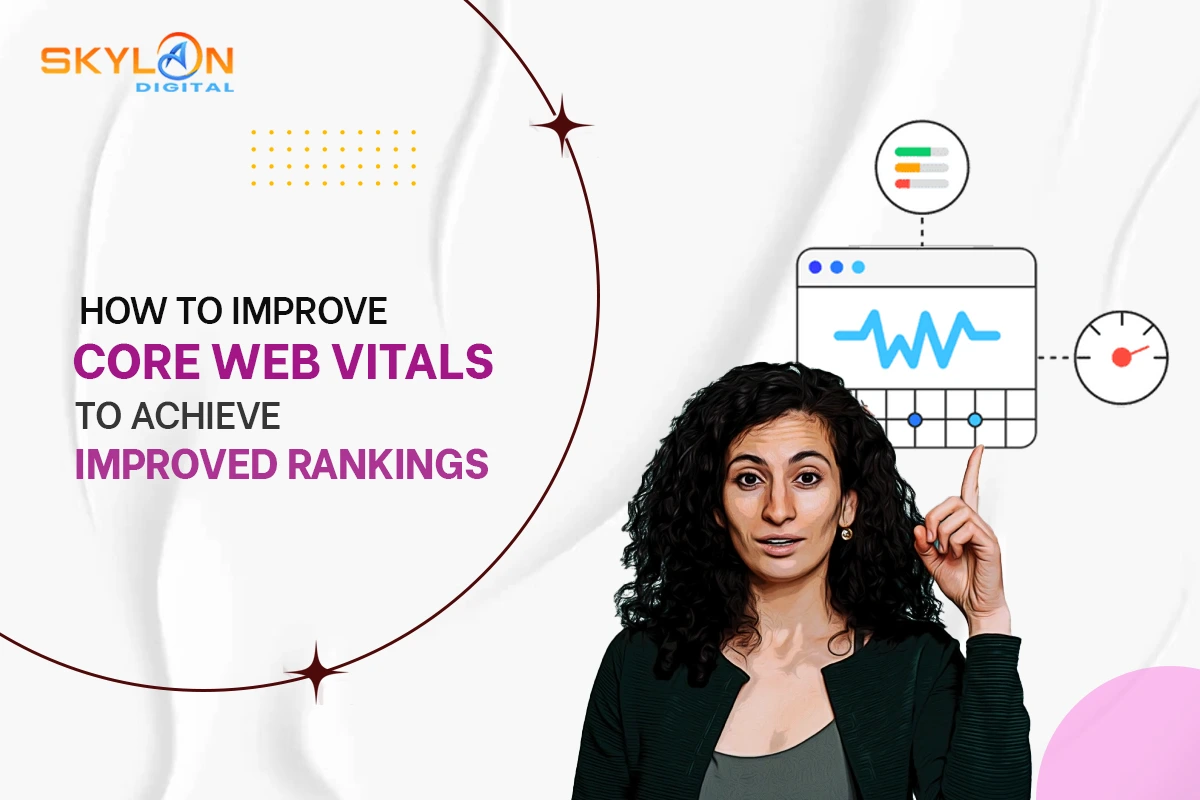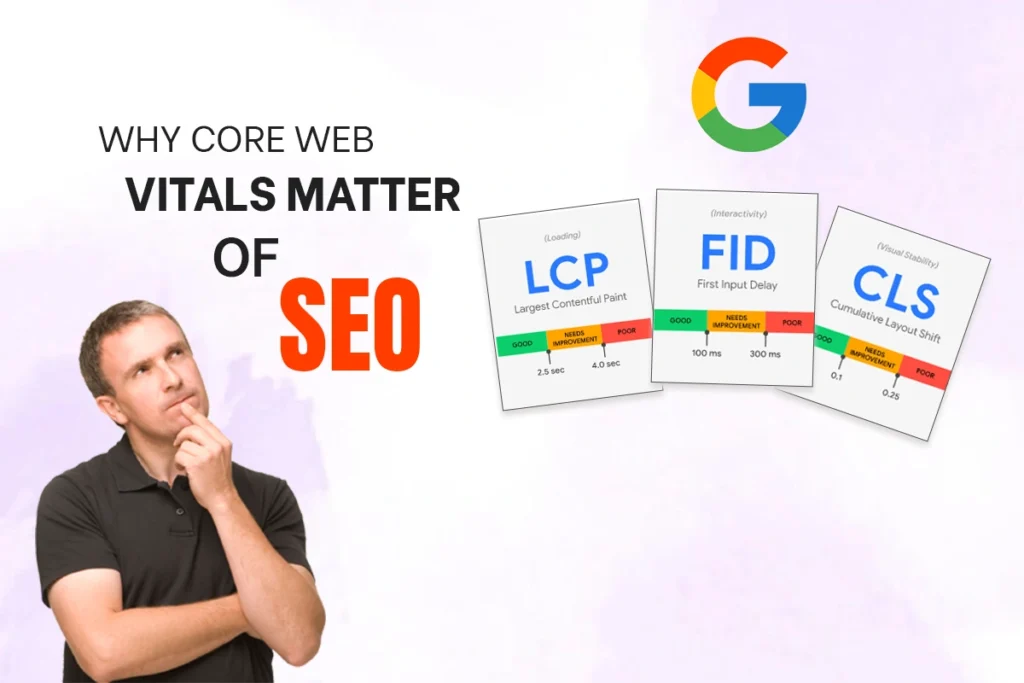
Search engines, particularly Google, have progressed much beyond simple keyword matching. Today, site performance, interactivity, and stability are just as important.This is where Core Web Vitals come into play.If you’re looking to improve Core Web Vitals and boost your visibility in search engine rankings, understanding the nuances of page speed optimization, user experience SEO, mobile-first SEO, and critical metrics like CLS and LCP is essential.
In this tutorial, we’ll segment actionable steps, tools, and information that will assist you in optimizing your website performance, keeping up with Google’s algorithm changes, and delivering a smooth experience to your users.
What Are Core Web Vitals?
Core Web Vitals are a collection of particular measures that Google identifies as critical in a webpage’s overall user experience SEO.They focus on how the user perceives a page’s speed, responsiveness, and visual stability.The three principal metrics are:
- LCP (Largest Contentful Paint): Loading performance. Target LCP at 2.5 seconds or less.
- FID (First Input Delay): Interactivity. Target under 100 ms.
- CLS (Cumulative Layout Shift): Computes visual stability. Target under 0.1.
Solving these will help you directly solve for Core Web Vitals, which will equate to improved search rankings and user retention.
Why Core Web Vitals Matter for SEO

Search engines focus more on user experience SEO these days, and this implies that Core Web Vitals are a ranking signal. With Google’s Page Experience Update, websites that score well on improve core web vitals are prioritized in SERPs.
- Major Advantages:
- Enhanced search visibility
- Increased user engagement
- Improved conversion rates
- Decreased bounce rates
Therefore, to improve core web vitals, you require focused effort on performance tuning and page speed optimization techniques.
Step 1: Audit Your Site with Google Tools
Evaluate your performance with tools, prior to making major changes like:
- Google PageSpeed Insights
- Google Search Console
- Lighthouse
- Web Vitals Extension
These tools display LCP and CLS scores and offer CLS and LCP suggestions particular to your webpage’s content and structure.
To actually improve Core Web Vitals, monitor these measures regularly and address pages with the most traffic or highest bounce rates.
Step 2: Optimize Page Speed
Core Web Vitals is built on the principles of page performance optimization. A slow-loading website annoys users and lowers ranking potential.
Techniques for Page Speed Optimization:
- Compress Images
- Utilize new formats such as WebP and optimize dimensions.
- Use a Content Delivery Network (CDN)
- It geographically disperses your content for quicker loading.
- Minimize JavaScript and CSS
- Defer unused scripts and utilize async loading.
- Enable Lazy Loading
- Load images and content as users scroll, not on initial load.
By using these methods, you’re not only improve Core Web Vitals but also boosting user experience SEO quite a bit.
Step 3: Mobile-First SEO Optimization
Mobile-first SEO is a term used to describe Google indexing your website according to its mobile version. If your mobile site is slow or unreliable, you’ll lose rankings.
Tips for Mobile-First SEO:
- Use responsive design
- Don’t use intrusive interstitials
- Optimize tap targets
- Use mobile-friendly fonts and layouts
- Avoid fixed-width layouts
Enhancing mobile-first SEO benefits your site to rank better in mobile search and also improves CLS and LCP scores by minimizing layout shifts.
Step 4: Apply CLS and LCP Advice
CLS (Cumulative Layout Shift) Advice:
- Always specify size attributes on image and video elements.
- Dynamically reserve space for ads.
- Don’t insert content above other content.
LCP (Largest Contentful Paint) Advice:
- Quickly load the main content (e.g., hero image or text).
- Preload vital resources like fonts and pictures.
- Eliminate unnecessary third-party scripts.
These CLS and LCP best practices will ensure you have visual stability and rapid rendering—two key components to improve core web vitals.
Step 5: Enhance Server Response Times
Server response time has a direct impact on LCP.If your server responds slowly, the LCP will be high. Here’s how you can enhance it:
- Optimize backend code and database queries
- Implement caching for static resources
- Minimize Time to First Byte (TTFB)
Fast server response improves page speed optimization processes and results in improved user experience SEO results.
Step 6: Employ Efficient Typography and Fonts
Custom fonts can slow down the rendering and add CLS. Keep the following in mind:
- Use system fonts where feasible
- Employ font-display: swap in CSS
- Preload key fonts
This keeps text on-screen during load, improving mobile-first SEO and reducing layout shifts.
Step 7: Defer Non-Critical JavaScript
Heavy JavaScript slows page painting and adds to FID, which in turn impacts LCP. Here is what to do with it:
- Reduce script duration
- Defer the third-party scripts
- Utilize async and defer attributes
Optimizing JavaScript bloat is critical to page speed optimization, user experience SEO, and to holistically improve core web vitals.
Step 8: Improve Interactivity Monitoring
FID is not a direct desktop Core Web Vital, but it does matter for mobile. Slow interaction means bad user experience SEO. You can:
- Minimize input delay
- Optimize main-thread work
- Break long tasks
This is important for mobile-first SEO and responsiveness.
Step 9: Don’t Load Heavy Third-Party Scripts
Analytics and ads are necessary, but too much third-party code hurts your metrics.
- Load third-party code after LCP
- Use tag managers to manage script behavior
- Audit script impact with Lighthouse
Strategic script management benefits both page load optimization and CLS and LCP enhancement.
Step 10: Apply Real-User Monitoring (RUM)
RUM assists in monitoring real users’ experience and Core Web Vitals over a period.
- Use New Relic, Datadog, or Google’s CrUX
- Measure performance on devices and networks
- Identify problems not detected in lab tests
Ongoing monitoring is the only method of sustainably optimizing Core Web Vitals and being ahead in user experience SEO.
Bonus: Focus on Above-the-Fold Content
Optimizing content above the fold guarantees rapid visual feedback, which leads to improved LCP.
- Inline critical CSS
- Preloading key images
- Avoid carousels with high headers
These modifications have a positive effect on mobile-first SEO and adhere to many CLS and LCP guidelines as well.
Conclusion
In order to improve core web vitals, the interaction between usability, performance, and content organization needs to be studied. Your page speed optimization, mobile-first search engine optimization, and visual stability efforts have a direct impact on the perception of your website by Google and your users. With the emergence of user experience SEO as a ranking factor, it’s no longer a choice but an imperative to make the changes associated with CLS and LCP.
By applying these strategies on a regular basis, employing the proper tooling, and maintaining user experience central, you can greatly enhance your SEO positions and have more satisfied users.
FAQs
Q1: What are Core Web Vitals in SEO?
Core Web Vitals are Google’s measurements of website speed, interactivity, and visual stability.
Q2: How does page speed optimization help SEO?
Page speed optimization minimizes load times, enhancing user experience and search engine rankings.
Q3: Why is mobile-first SEO crucial?
Mobile-first SEO guarantees your site to rank on mobiles, which Google considers for indexing.
Q4: Best CLS and LCP tips?
Save space for media, preload resources, and defer unused scripts to optimize CLS and LCP.
Q5: How to improve core web vitals in a hurry?
Audit using PageSpeed Insights, fix images and scripts, and apply layout stability patches.






